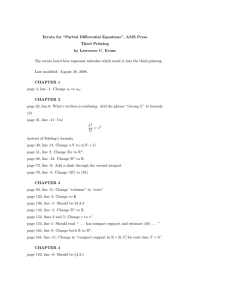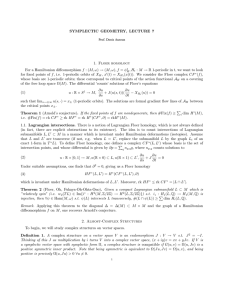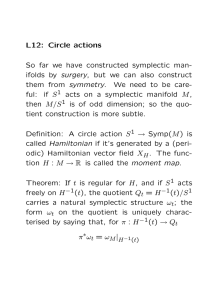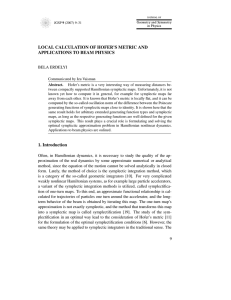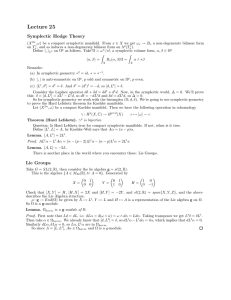PDF - Academia Sinica
advertisement
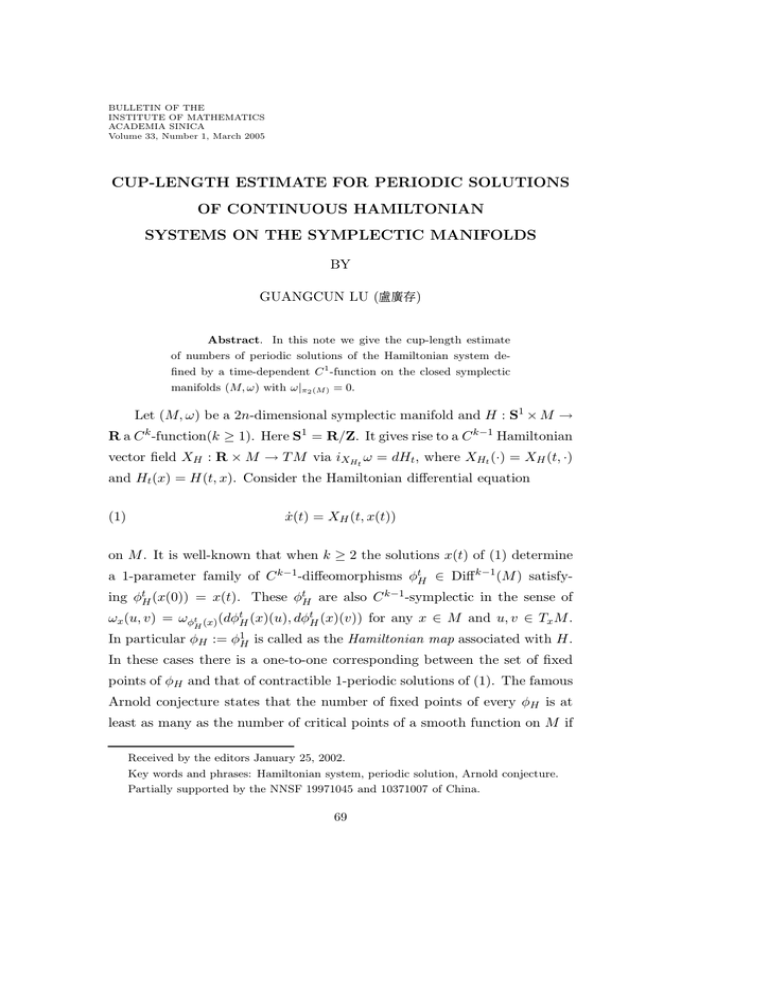
BULLETIN OF THE
INSTITUTE OF MATHEMATICS
ACADEMIA SINICA
Volume 33, Number 1, March 2005
CUP-LENGTH ESTIMATE FOR PERIODIC SOLUTIONS
OF CONTINUOUS HAMILTONIAN
SYSTEMS ON THE SYMPLECTIC MANIFOLDS
BY
GUANGCUN LU (盧廣存)
Abstract. In this note we give the cup-length estimate
of numbers of periodic solutions of the Hamiltonian system defined by a time-dependent C 1 -function on the closed symplectic
manifolds (M, ω) with ω|π2 (M ) = 0.
Let (M, ω) be a 2n-dimensional symplectic manifold and H : S1 × M →
R a C k -function(k ≥ 1). Here S1 = R/Z. It gives rise to a C k−1 Hamiltonian
vector field XH : R × M → T M via iXHt ω = dHt , where XHt (·) = XH (t, ·)
and Ht (x) = H(t, x). Consider the Hamiltonian differential equation
(1)
ẋ(t) = XH (t, x(t))
on M . It is well-known that when k ≥ 2 the solutions x(t) of (1) determine
a 1-parameter family of C k−1 -diffeomorphisms φtH ∈ Diff k−1 (M ) satisfying φtH (x(0)) = x(t). These φtH are also C k−1 -symplectic in the sense of
ωx (u, v) = ωφt
H (x)
(dφtH (x)(u), dφtH (x)(v)) for any x ∈ M and u, v ∈ Tx M .
In particular φH := φ1H is called as the Hamiltonian map associated with H.
In these cases there is a one-to-one corresponding between the set of fixed
points of φH and that of contractible 1-periodic solutions of (1). The famous
Arnold conjecture states that the number of fixed points of every φH is at
least as many as the number of critical points of a smooth function on M if
Received by the editors January 25, 2002.
Key words and phrases: Hamiltonian system, periodic solution, Arnold conjecture.
Partially supported by the NNSF 19971045 and 10371007 of China.
69
70
GUANGCUN LU
[March
H is smooth([1]). Its homological version is
♯FixφH ≥ cuplength(M ) + 1.
(2)
So far for many symplectic manifolds the estimate (2) has been proved( see
[3, 4, 6, 10]). For Arnold’s original conjecture some progress had also been
made in [8].
From the views of the dynamic system and application the case of k = 1
is very important and interesting. However, in this time the vector field XH
is merely continuous, and thus the uniquess of 1-periodic solutions of (1)
through a given point on M can not be ensured in general. Furthermore,
one cannot talk anything about φH yet. In fact, approximating it with the
smooth Hamiltonians and directly applying the conclusion of the smooth
Hamiltonian one can only prove that (1) has at least one solution. The
main result of this note shows that the estimate (2) is still valid for C 1 Hamiltonian. In order to illustrate the precise sense of it we define a setvalued map ψH : M → 2M as follows: for every x ∈ M
(3)
ψH (x)
is defined to be the subset of M consisting of all points y for which there exist
a sequence of smooth functions Hk : S1 × M → R such that limk→∞ kHk −
HkC 1 = 0 and φHk (x) → y. It is easy to check that this set-valued map is
always nonempty and becomes the usual Hamiltonian map φH when H is
C 2 -smooth. A point x ∈ M is called as the fixed point of ψH if x ∈ ψH (x).
Denote by P(H) the set of all contractible 1-periodic solutions of (1). It
should be noted that in present case there is no obvious bijection between
Fix(ψH ) and P(H). But if we replace P(H) by its subset P0 (H) of all
1-periodic solutions y of (1) for which there exist a sequence of smooth
functions Hk : S1 × M → R with limk→∞ kHk − HkC 1 = 0 and yk ∈ P(Hk )
C1
such that yk −→ y, then it is easy to prove that every element in P0 (H) may
determine a fixed point of ψH and different elements does its distinct fixed
points.
2005]
CUP-LENGTH ESTIMATE
71
When k ≥ 2 it is not hard to verify that P0 (H) = P(H), and it easily
follows from the arguments in [3, 6] that (2) holds. In this note we actually
prove the following theorem.
Main Theorem. For a closed symplectic manifold (M, ω) with ω|π2 (M )
= 0, if the equation (1) defined by a C 1 -function H : S1 × M → R has only
finite many contractible 1-periodic solutions it holds that
♯P0 (H) ≥ cuplength(M ) + 1.
(4)
Consequently, in this case ♯Fix(ψH ) ≥ cuplength(M ) + 1 for ψH defined by
(3). Furthermore, every Hamiltonian system associated with a C 1 -function
H : S1 × M → R has at least cuplength(M ) + 1 contractible 1-periodic
solutions.
Proof. The arguments will proceed along line of [3, 6]. In particular we
adopt notations in [6] without special statements. First of all, we point out
that under our assumption there are no nonconstant J-holomorphic spheres
for any J ∈ J (M, ω). Therefore, it follows from Corollary 4.2 in [6] that the
associativity of the cap action holds. For a given C 1 -smooth H : S1 ×M → R
we first take a sequence of smooth functions H̃k : S1 × M → R such that
kH̃k − HkC 1 <
1
k
for every k ≥ 1, then for each fixed k pick a F-generic
pair([6, p.277]) (Hk , Jk ) such that kH̃k − Hk kε <
1
k
and Jk ∈ U 1 (J0 ). Here
k
J0 ∈ J (M, ω) is fixed and U 1 (J0 ) as in [5,§2]. By the definition of the norm
k
k · kε in [2] it must hold that
(5)
lim kHk − HkC 1 = 0.
k→∞
From Gromov’s compactness theorem and Lemma 3.5 in [7] it follows that
there exists a positive constant ~0 > 0 such that (i) E(v) ≥ ~0 for any
nonconstant Jk -holomorphic sphere v : S2 → M and k = 0, 1, · · ·, (ii) E(u) ≥
~0 for any nontrivial s-dependent solution u : R × S1 → M of
(6)
∂u
∂u
+ Jk (u)
+ ∇Hk (t, u) = 0
∂s
∂t
or
∂u
∂u
+ J0 (u)
+ ∇H(t, u) = 0.
∂s
∂t
72
GUANGCUN LU
[March
Here the energy
E(v) =
Z
S2
v∗ ω
and E(u) =
Z
∞
Z 1
∂u 2
dtds.
−∞ 0
∂s
Note that the above connecting orbits determined by H is only C 1 because
of our H being C 1 . Hence we make use of Lemma 3.5 in [7] instead of
Theorem 3.3 in [5]. From now on we assume that M is embedded in Rq
for a sufficiently large q. By means of the Ascoli-Arzela’s theorem it follows
from limk→∞ kHk − HkC 1 = 0 that for any ǫ > 0 there exists k0 such that
every y ∈ P(Hk )(k ≥ k0 ) satisfies ky − y0 kC 1 < ǫ for some y0 ∈ P0 (H).
By the assumption P(H) is a finite set. Let
P(H) := {y1 , . . . , yp }.
Here it should be emphasized that unlike the case of C k -smooth(k ≥ 2) the
elements of P(H) are not necessiarly isolated. That is, even if yi 6= yj for
i 6= j we cannot guarantee yi (S1 ) ∩ yj (S1 ) = ∅. But there must be a t0 ∈ S1
such that yi (t0 ) 6= yj (t0 ). In fact, maxt∈S1 |yi (t) − yj (t)| > 0. Therefore, we
need to modify the definition of ǫ0 in Lemma 5.1 of [6] as follows. Firstly,
we define
ǫ(yi ) := min{d(yi , yj ) : yi (S1 ) ∩ yj (S1 ) = ∅, j 6= i}
ǫ̂(yi ) := min{max |yi (t) − yj (t)| : yi (S1 ) ∩ yj (S1 ) 6= ∅, j 6= i}
t∈S1
for every yi ∈ P(H). Here ǫ(yi ) and ǫ̂(yi ) are understood as +∞ as the
minimum is taken in an empty set. Then min{ǫ(yi ), ǫ̂(yi )} is always a finite
positive number as p > 1. Denote by
ǫ0 := min min{ǫ(yi ), ǫ̂(yi ), 1}.
yi ∈P(H)
Lemma 1.([6, lemma 5.1]) For any ǫ ∈ (0, ǫ0 ) there exists an integer
k1 ≥ k0 such that if k ≥ k1 and a connecting orbit u between 1-periodic
2005]
CUP-LENGTH ESTIMATE
73
solutions z and z ′ in P(Hk ) satisfy:
E(u) ≤
~0
2
and kz − z0 kC 1 ≤
ǫ
2
for some z0 ∈ P0 (H),
then u(R × S1 ) must be contained in 2ǫ-neighborhood of z0 .
For convenience we sketch its proof though it is almost a repeat of that
in [6].
Proof of Lemma 1. Assume that there exists a 0 < ǫ < ǫ0 , and a sequence
of connecting trajectories ukj between zkj ∈ P(Hkj ) and zk′ j ∈ P(Hkj ) such
that
E(ukj ) ≤
~0
2
and kzkj − z0 kC 1 ≤
ǫ
2
for some z0 ∈ P0 (H),
and ukj (R × S1 ) cannot be contained in 2ǫ-neighborhood of z0 . Then for
every fixed j and sufficiently large −s ∈ R it holds that
kukj (s, ·) − z0 kC 1 ≤ kukj (s, ·) − zkj kC 1 + kzkj − z0 kC 1 < ǫ,
sj := sup{s ∈ R |
sup
τ ≤s,t∈S1
|ukj (τ, t) − z0 (t)| < ǫ} ∈ R.
Let ukj · sj (τ, t) = ukj (τ + sj , t). Replaceing ukj with ukj · sj we may assume
that ukj satisfies
(7)
|ukj (τ, t) − z0 (t)| < ǫ, ∀τ < 0, t ∈ S1 .
But that ukj (R × S1 ) cannot be contained in 2ǫ-neighborhood of z0 implies
that
(8)
|ukj (0, tj ) − z0 (tj )| = ǫ
for a sequence tj ∈ S1 and j = 1, 2, · · ·. Without loss of generality we may
assume tj → t∗ ∈ S1 . Since ω|π2 (M ) = 0 and E(ukj ) ≤ ~0 /2, the weak
compactness arguments shows that after passing to a subsequence ukj con1 -topolgy, where u
verges to u∞ in Cloc
∞ is a solution of the second equation
in (6) and E(u∞ ) ≤ ~0 /2. By (7) it holds that |u∞ (τ, t) − z0 (t)| < ǫ for
74
GUANGCUN LU
[March
all τ < 0 and t ∈ S1 . This leads to |u∞ (−∞, t) − z0 (t)| ≤ ǫ for all t ∈ S1 .
Now our definition of ǫ0 above shows that u∞ (−∞, ·) = z0 (·). Moreover
(8) implies that |u∞ (0, t∗ ) − z0 (t∗ )| = ǫ. Hence u∞ is nontrivial. It follows
from the definition of ~0 above that E(u∞ ) ≥ ~0 . But Fatou lemma leads to
E(u∞ ) < ~0 /2. This contradiction completes the proof.
Continuing Proof of Main Theorem. As in [6] it suffice to prove that if
there exist m elements of positive degree αi ∈ H li (M ; Z2 ), i = 1, · · · , m, such
that (α1 ∩)◦· · ·◦(αm ∩) acts on the Floer homology F H∗ (M ; Z2 ) nontrivially,
then ♯P0 (H) ≥ m + 1. By the definition of P0 (H) any sequence xk ∈
P(Hk ) approximating the elements of P0 (H) in C 1 -topology. Under the
above assumptions the definition of the cap action shows that there exist
the sequences of elements z̃ki ∈ P̃(Hk ), i = 0, · · · , m, such that
µ(z̃ki ) − µ(z̃ki+1 ) = li
and
mαj (z̃ki , z̃ki+1 ) = 1.
Let z̃ki = [zki , vki ]. Passing to a subsequence we may assume that zki → z0i ∈
P0 (H) in C 1 -topology for i = 0, . . . , m. We wish to prove that z0i 6= z0j for i <
j. Otherwise, assume z0i = z0j for some i < j. Since M(z̃kl , z̃kl+1 ; Hk , Jk ) 6= ∅
for l = 0, · · · , m, it holds that aHk (z̃ki ) > aHk (z̃ki+1 ) ≥ · · · ≥ aHk (z̃kj ). Here
(9)
aHk (z̃) = −
Z
D2
∗
v ω+
Z
1
H(t, z(t))dt for z̃ = [z, v] ∈ L̃(M ).
0
For any uik ∈ M(z̃ki , z̃ki+1 ; Hk , Jk ) the direct computation shows
E(uik ) = aHk (z̃ki ) − aHk (z̃ki+1 )
(10) ≤ aHk (z̃ki ) − aHk (z̃kj )
= −
Z
D2
(vki )∗ ω+
Z
D2
(vkj )∗ ω+
Z
0
1
Hk (t, zki (t))dt−
Z
1
0
Hk (t, zkj (t))dt.
We say that the case (b) in the proof of lemma 5.2 of [6] cannot occur in the
case of ω|π2 (M ) = 0. That is, lim supk→∞(aHk (z̃ki ) − aHk (z̃ki+1 )) is not more
than ~0 /2. In fact, for sufficiently large k both zki and zkj are sufficiently
close to z0i = z0j . Thus we can choose a homotopy Wkij : S1 × [0, 1] → M
2005]
CUP-LENGTH ESTIMATE
75
between zki and zkj whose image set is contained in a small neighborhood of
z0i (S1 ) = z0j (S1 ). Gluing it with vki and vkj together one get a map gkij : S2 =
D 2 ♯S1 × [0, 1]♯(−D2 ) → M and easily check its homotopy class [gkij ] being
independent of the choice of Wkij . Therefore (10) becomes
Z
1
0
Hk (t, zki (t))dt
−
Z
0
1
Hk (t, zkj (t))dt
−
Z
S1 ×[0,1]
(Wkij )∗ ω + h[ω], [gkij ]i.
But h[ω], [gkij ]i = 0. The third term and the difference of the first and second
terms trend all to zero as k → ∞ we arrive at the conclusion. Hence
lim sup(aHk (z̃ki ) − aHk (z̃ki+1 )) ≤ lim sup(aHk (z̃ki ) − aHk (z̃kj )) ≤ ~0 /2,
k→∞
k→∞
that is, only case (a) may holds. As in [6] one can still get a contradiction
in this case. The main theorem is proved.
Remark 2. We here cannot generalize Main Theorem in [6] to the case
of H being only C 1 -smooth. The difficulty is that we now cannot ensure
Claim 5.4 there holds yet. In fact, the Conley-Zehnder index of solutions
in P(H) is not defined whether we take the methods in [9] or [6] since we
cannot linearize the equation ẋ = XH (x) along its solutions under our case.
Thus the proof of Claim 5.4 in [6] does not work for our case. On the other
hand if there are two distinct zk , zk′ ∈ P(Hk ) such that both {zk }∞
k=1 and
1
{zk′ }∞
k=1 converge to some z ∈ P(H) in C -topology, then for bounding disks
vk and vk′ obtained by the procedure described in the proof of Lemma 5.2
of [6] we cannot ensure that the paths of symplectic matrices {Φzk (t)}0≤t≤1
and {Φzk′ (t)}0≤t≤1 defined by (5.1) in [9] are C 0 -close each other as k → ∞.
1
The reason is that the sequence {Hk }∞
k=1 is only C -convergent, and the
definitions of Φzk (t) and Φzk′ (t) involved the second deriviates of Hk which
must not converge. Therefore, it is very interesting question whether one
can find a C 1 -smooth function on some closed symplectic manifold (M, ω)
satisfying Main Theorem in [6] such that ♯P(H) < cuplength(M ) + 1.
Finally, carefully checking the proofs of Theorem A.2.1 and Proposition
A.2.5 in [6] it is not hard to find that the case (b) in the proof of Lemma
76
GUANGCUN LU
[March
5.2 there cannot happen. Thus we may make use of our above methods to
prove:
Proposition 3. Let ωi be the standard symplectic form on CPni with
h[ωi ], [CP1 ]i = 1 and M = CPn1 × · · · × CPnk . Denote by
Ω := (n1 + 1)ω1 ⊕ · · · (nk + 1)ωk
and
Ω′ := m1 ω1 ⊕ · · · ⊕ mk ωk .
Here m1 , · · · , mk are positive integers. Then for every C 1 -smooth timedependent Hamiltion H : S1 × M → R the number of contractible 1-periodic
solutions of ẋ = XHt (t, x) is greater than or equal to the greatest common
′ (t, x) is at least max{(n + 1)/m }.
divisor of {ni + 1}, but that of ẋ = XH
i
i
t
′
′ are given by i
′ Ω = dHt respectively.
Here XHt and XH
XHt Ω = dHt and iXH
t
t
References
1. V. I. Arnold, Mathematical Methods in Classical Mechanic, Appendix 9, Springer
Verlag, New York, 1978.
2. A. Floer, The unregularied gradient flow of the symplectic action, Comm. Pure.
Appl. Math., XLI (1988), 775-813.
3. A. Floer, Symplectic fixed points and holomorphic spheres, Comm. Math. Phys.,
120(1989), 575-611.
4. H. Hofer, Ljusternik-Schnirelmann theory for Lagrangian intersections, Ann.
Poincaré Analyse Nonlinéaire., 5(1998), 465-499.
5. H. Hofer and D. Salamon, Floer homology and Novikov rings, In Floer Memorial
volume. Hofer et al. eds. Birkhäuser Verlag, Progress in Math., 133(1995), 483-524.
6. Lê Hông Vân and K. Ono, Cup-length estimates for symplectic fixed points, In
Contact and Symplectic Geometry, C. B. Thomas eds., Cambridge University Press 1996,
131-148.
7. Lê Hông Vân and K. Ono, Symplectic fixed points, the Calabi invariant and
Novikov homology, Topology., 34(1)(1995), 155-176.
8. Yu. B. Rudyak, On analytical applications of stable homotopy (the Arnold conjecture, critical points), Preprint, 1998.
9. D. Salamon and E. Zehnder, Morse theory for periodic solutions of Hamiltonian
systems and the Maslov index, Comm. Pure and Apll. Math., 45 (1992), 1303-1360.
10. M. Schwarz, A quantum cup-length estimate for symplectic fixed points, Inven.
Math., 133 (1998), 353-397.
Department of Mathematics, Beijing Normal University, Beijing 100875, P. R. China.
E-mail: gclu@bnu.edu.cn.

